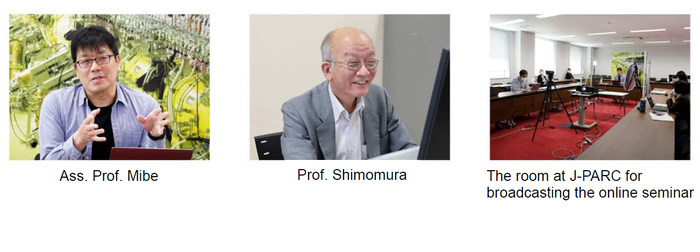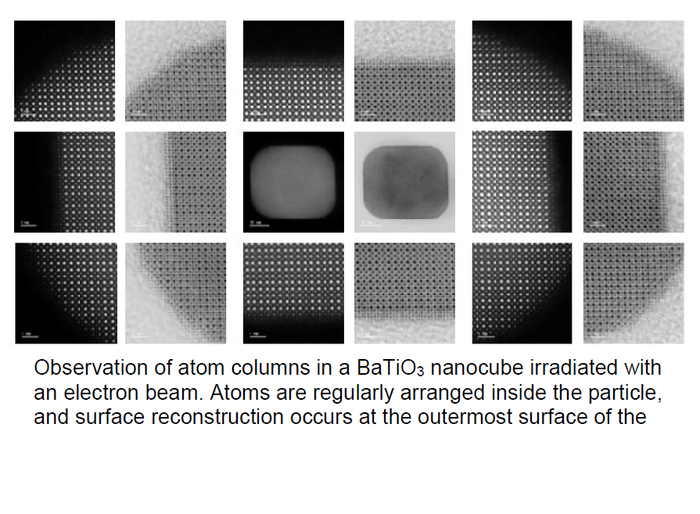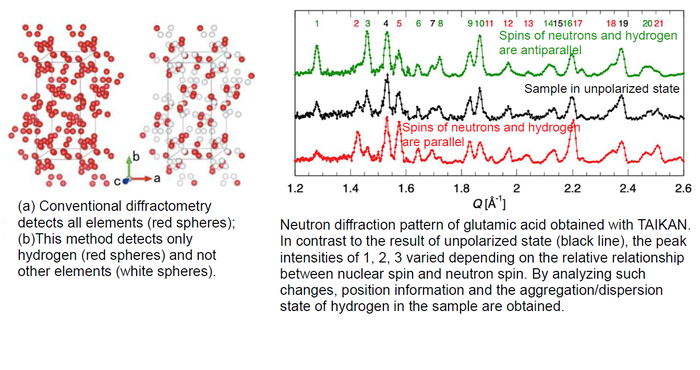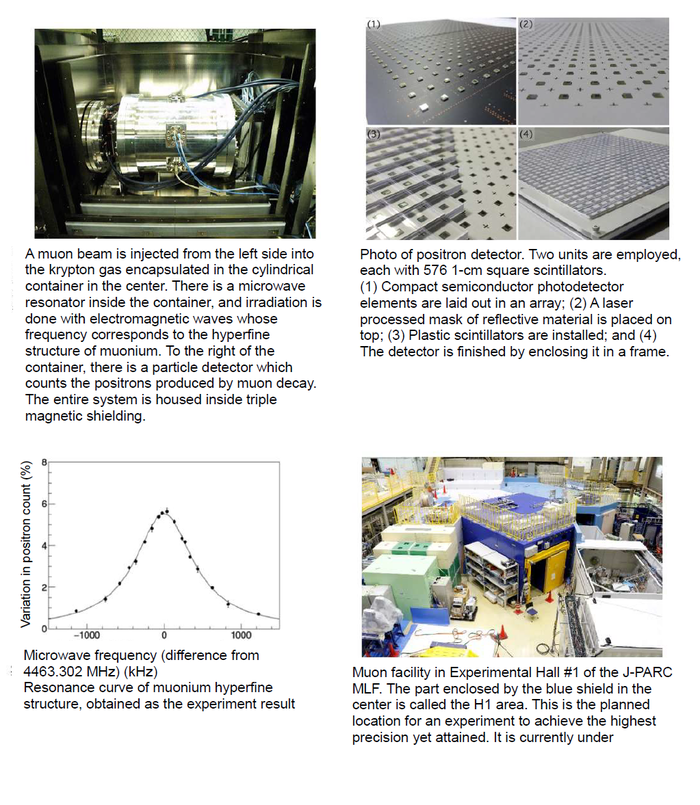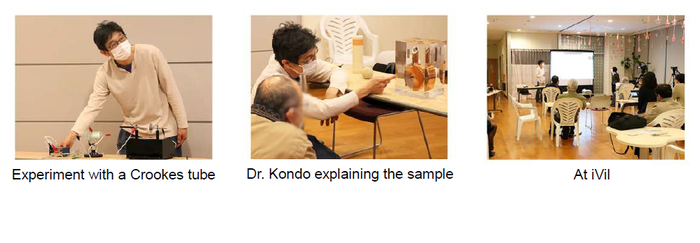J-PARC News May (Issue #193)
■First Media Salon, J-PARC Media Seminar Held: "A full explanation of the latest news on the muon g-2 experiment. Will new physics be discovered beyond the standard model?!" (April 22)
On April 7, Fermi National Accelerator Laboratory (Fermilab) in the U.S. announced results for the measurement of anomalous magnetic moment (g-2) of muon. As suggested in the prior experiment, measured value of g-2 was reconfirmed to be larger than the prediction by the standard model of particle physics. This has attracted a great deal of attention among researchers all over the world. An online seminar was organized for the media on this topic. The seminar explains an overview of the planned experiment at J-PARC by an international collaboration, differences between the Fermilab experiment and the J-PARC experiment, and other related topics. A high level of interest was evident as there were 22 media participants from 9 companies.
Prof. Mibe, a staff member of the J-PARC center, associate professor in KEK* explained the new Muon g-2 experiment to be conducted at J-PARC. Prof. Shimomura, deputy division head of MLF, professor in KEK explained research aiming to improve the accuracy of g-2 determination by using muonium.
If the discrepancy from the theory prediction is independently verified by the J-PARC experiment with a new technique, researchers expects that they would finally grasp the sign of new physics beyond the standard model.
* Professor since June 1, 2021.
■Successful Synthesis of Barium Titanate Nanocube and Visualization of Atom Arrangement on Particle Surface: Expectations for Development of High-Performance, Compact Electronic Devices (Press Release on March 31)
Barium titanate (BaTiO3) is a ferroelectric substance which can electrically polarize and store electricity when voltage is applied, and thus is used in mobile phones, PCs, and other electronic devices. Improving the performance of dielectric materials using BaTiO3 will aid in the development of high-performance, compact electronic devices. Design of the basic BaTiO3 particles, particularly material design exploiting the particle surface, will be crucial for this purpose.
Associate professor Kouichi Nakashima of Ibaraki University et al. have successfully synthesized a nanocube, i.e., a cubic monocrystalline particle of BaTiO3 sized at the nanometer level. BaTiO3 nanocubes enable material design exploiting the particle's surface. Neutron diffractometry of this nanocube was carried out using J-PARC's IBARAKI Materials Design Diffractometer (BL20 iMATERIA), and X-ray diffractometry was carried out at SPring-8. These studies revealed a tetragonal crystalline structure, and sites were discovered that serve as the origin of spontaneous polarization in BaTiO3. Furthermore, electron microscope observation showed that titanium and barium are regularly aligned inside particles of the nanocube, but the particle surface is composed of titanium columns. The results of this research are expected to be a major step in the field of material design based on particle design.
■Development of Structural Analysis Technique Employing Polarized Neutron Diffraction for Nuclear Spin Polarized Samples: Selective Extraction of Hydrogen Position Information (Press Release on April 1)
Neutrons are better than X-rays for revealing hydrogen in matter, but elements other than hydrogen are also observed at the same time, so ingenuity is needed to observe only hydrogen. The nucleus of hydrogen and the neutron both have a magnetic property called "spin," and the scattering intensity of neutrons due to hydrogen nuclei varies greatly between the cases where the two spin directions are parallel, and antiparallel. Both the hydrogen nuclei in the sample and the irradiated neutrons normally have uncoordinated spins, but if their spins are aligned (i.e., if they are polarized), then the component whose intensity varies between the parallel and antiparallel case can be extracted as the scatter component due to hydrogen nuclei. However, it is difficult to polarize hydrogen nuclei in a crystal.
Daisuke Miura et al. from Yamagata University successfully polarized hydrogen nuclei in glutamic acid (a type of amino acid) using a nuclear spin polarization method developed for research in nuclear physics. They then carried out neutron diffraction experiment using a polarized neutron beam at Small and Wide Angle Neutron Scattering Instrument (BL15 TAIKAN) of J-PARC. The results showed the positional correlation between hydrogen atoms and other elements, and the aggregation/dispersion state of hydrogen in the sample were directly measured. This study is expected to contribute to the structural analysis of crystal samples containing hydrogen, such as hydrogen functional materials, polymers, and biopolymers, and help in the elucidation of material functions and development of new materials.
■Searching for Unknown Physical Phenomena with "Ideal Hydrogen Atom": Launch of Microwave Spectroscopy Experiment on Muonium (Press Release on April 16)
The simplest atom existing in nature is the hydrogen atom composed of a proton and an electron, but it is possible to artificially create an atom called "muonium" very similar to hydrogen using an elementary particle called the muon. The proton which is the nucleus of hydrogen is a composite particle made up of three quarks, and has a complex internal structure. Muonium, on the other hand, is composed only of elementary particles, and is an "ideal hydrogen atom" whose properties can be precisely calculated using a theory called quantum electrodynamics. The correctness of that theory can be verified by comparing experimental results and theoretical calculations at high precision, and if there is a significant deviation, no matter how slight, this will indicate an unknown physical phenomenon that cannot be explained in the existing framework. The hyperfine structure of muonium is suited to this purpose, and experiments have previously been conducted at Los Alamos National Laboratory (U.S.). The experiment results matched with theoretical values to a high degree of precision, but there were limits on the number of muonium atoms that could be prepared, and thus it looked difficult to improve precision beyond that.
Assistant Professor Kanda (KEK) et al. from the J-PARC Center have shown that the hyperfine structure of muonium can be precisely measured by using a subdivided positron detector capable of exactly counting the large number of particles produced by the high-intensity pulsed muon beam and the high-intensity beam in the D2 beamline of the muon instrument. If this experiment is carried out with the new beamline that is currently under construction, it should be possible to improve the world record set in previous experiments by 10 or more times in a 40-day experiment period.
■J-PARC Hello Science "Learning How Accelerators Work using Familiar Scientific Principles" (April 23, Tokai Industry and Information Plaza "iVil")
In addition to the previous in-person lecture format at the iVil venue, this time the event was also held with an online component, and 7 participants joined online in addition to 10 participants who came to iVil.
At this event, Dr. Yasuhiro Kondo of the Accelerator Division introduced the accelerators at J-PARC. He began by explaining what acceleration is, and the mechanism of electrostatic acceleration, while conducting experiments like applying voltage inside a Crookes tube. After that, he explained acceleration cavities while presenting the drift tube linac as an example, and talked about how the principle is simple but actually building and operating a linac is difficult.
We will continue to use the combined offline/online format in the future, and we hope those located far away will freely participate.
Pre-registration is required by email. Visit the link below for further details. https://j-parc.jp/c/events/2021/05/06000677.html
<Information>
■Special Exhibition at the National Museum of Nature and Science, Tokyo
From July 13 to October 3, the special exhibition "Accelerators: Pursuing the Mysteries of the Universe, Matter, and Life at Enormous Experimental Facilities" will be held at the Ueno Main Building of the National Museum of Nature and Science. The details will be available in our website later.
■Sanpo-michi #10: A Small Crab’s Journey
When our staff came to work one morning, a small crab was shining in the sun in front of the entryway to the J-PARC Research Building. It seemed to be a type of shore crab.
The straight-line distance from the shoreline to where the crab was found is about 200 m. In between, there is the embankment of J-PARC's largest MR accelerator, which is a giant ridge for a crab. The crab might have come through drainage gutters, but that would be quite a roundabout route. It's a mystery how a shore crab living in the ocean safely arrived at our building.
The crab tried its best to be threatening, but was quickly caught in a small bottle, and released on the near side of the shoreline fence. It scampered across a hill of sand to the ocean, and it was impressive to see the strong life force of such a small animal.
During the lunch break that day, I went to a bird bath near our building, and saw the claw of a crab a little larger than that of the earlier crab.
A bird probably brought the crab in its mouth, left the claw and flew away. The one claw had shriveled up under the sun.
It was a day that showed the life force of animals, and the transience of animal life.

